Translation by Bo Brændstrup.
Click!
“Autosequence start, T-30 seconds.”
The LED next to the mission box button marked autosequence start lights up to tell me that the launch control interface aboard Sputnik has received the command. The first launch by CS since Sapphire
in 2013 will happen in 30 seconds. I’m standing on the open bridge on Vostok. André and Johansen are at the helm, to my left is a photographer from Discovery Channel. To my right Flight Dynamics Officer Wilson and Guidance Officer Nyboe are seated, each in front of a laptop. “T-20 seconds” is announced over the radio by Scott who is in charge of the count down from his seat in the wheelhouse beneath me.
The seconds ticks by at a snail’s pace. “T-5 seconds” is announced by Scott. An eternity later followed by “Ignition!” But nothing happens! I remember the day when HEAT-1X remained standing on the launch platform. It’s a catastrophe if this happens again… “Liftoff” the radio blares. And lo and behold, Nexø I moves up the rail! Before the rocket has left the rail it is clear that something is wrong, the acceleration is too small, and I realise that we will not reach the anticipated altitude.
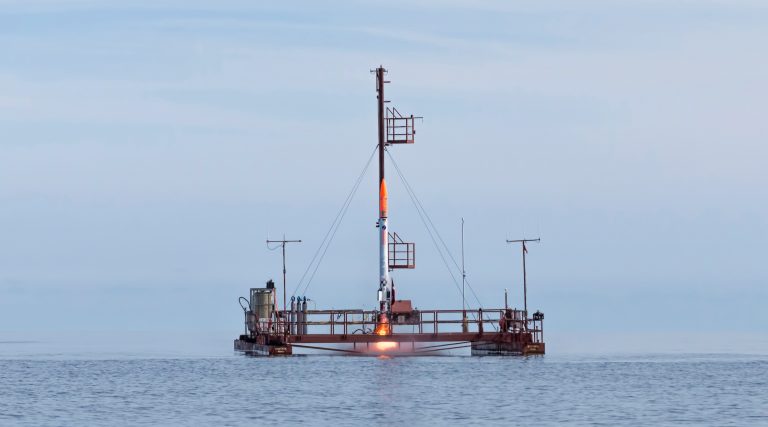
Nexø I moving up the rail. Photo: Carsten Olsen.
Nexø I climbs majestically on an almost invisible column of flames, a truly awesome sight. I have to lean very far over the bridge railing to look past the improvised sun roof that we have put up. Nexø I looses speed, we are close to MECO, moments later a white column is trailing Nexø I. MECO! I look over at Wilson to get an indication of speed and altitude. The FIDO system is missing the crutial GPS lock and is unable to aid me. For a brief time the rocket is out of my view, and as I see it again it is past apogee. No parashute … I press the mission control button to activate manual deployment of the nosecone. Nothing happens. I try again. Nothing. From now on the altitude is insufficient to allow the parashute to deploy fully, it will be better to impact the sea vertically, and see if the rocket will resurface.
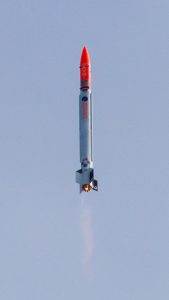
Nexø I while it was still gaining altitude. Photo: Morten bulskov.
Nexø I impacts the sea and silence is total. I doubt that it will resurface and have time to think that we better start packing and head home. 10 seconds later Nexø I shoots out of the water. Although this was hoped for, I’m flappergasted and let out a howl. The Discovery Channel photographer has his camera right in my face. This will look pretty silly on TV is my first thought. Wilson calls “splashdown” on the radio and blue RIB immediately responds. There’s obviously still LOX in the tank, it is boiling off through the engine because the main valve is still open. Per manages to secure the rocket with a line, and shortly after Vostok arrives to take the rocket aboard.
This was more or less what happened a couple of days ago on the Baltic Sea. If you haven’t watched Mejlings video from the launch, here it is.
Ahead of launch we had some pretty hectic days and nights. To launch a rocket from a platform 30 km out at sea is not a trivial matter, let’s look back at the week leading up to launch.
Monday July 18th we have our usual status meeting, most important point on the agenda is determining whether the following weekend will offer suitable weather, and whether we are ready if this is the case. We quickly agree that we are ready and the weather is GO. Monday evening CS enters red alert readiness, liftoff is now 113 hours away. All hardware is still on Refshaleøen and coordination of personel and logistics will have to be performed flawlessly to get all the gear to Spaceport Nexø. Tuesday afternoon Sputnik leaves for Nexø with Elof, Carsten, Jop, and Jens. Carsten and Jens will also have to sail Antares from Copenhagen to Bornholm, which means they will have to return home directly to be able to make it in time. Carsten and Jens will get very little sleep the coming week.
Wednesday Vostok leaves for Nexø, unfortunately not until midnight, partly because a sea test had to be passed to make shure the recent problems had been solved satisfactorily. Uffe and Christian also leaves for Nexø on this night in a hired van. They are bringing Nexø I and a large amount of support equipment to Nexø.
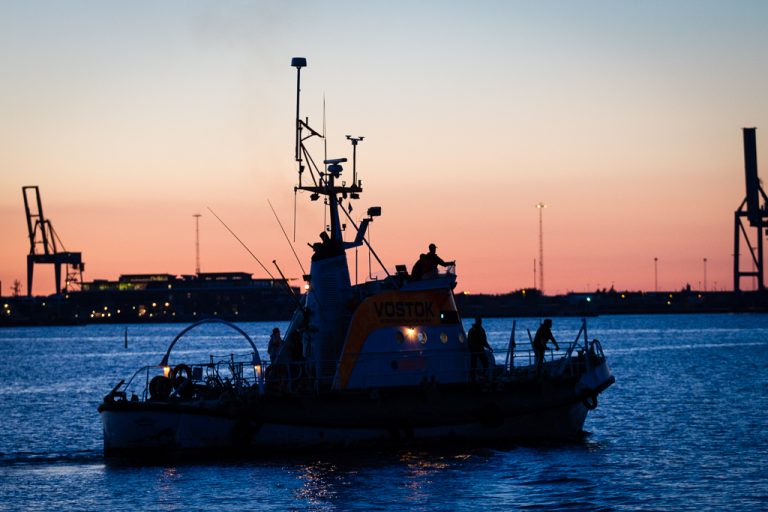
Vostok leaving Copenhagen Wednesday evening. Photo: Thomas Pedersen.
Thursday afternoon most of CS is assembled on the quay in Nexø. Scott is very busy as usual, as he’s responsible for both launch network and streaming network. This includes, among countless other tasks, mounting the WiFi link antenna on Bornholmertårnet (Bornholm Tower) at
Dueodde. Towards evening, when most hardware related tasks are done, we get a unpleasant surprise. The parashute is nowhere to be found.
The Stream Team in the workshop at home can confirm that the parashute is indeed still in Copenhagen. Panic is spreading until we recall that Danish Space Challenge will leave for Bornholm by ferry from Køge, close to Copenhagen, in a few hours time. Huge thanks to DSC for delivering the parashute.
Friday is the day for the major part of the preparations. All tasks are taken care of with gusto, although in a less timely manner.
We are not ready to hoist Nexø I onto the rail before 5 PM.
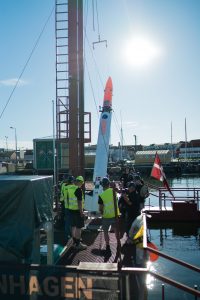
Nexø I is hoisted onto the rail on Sputnik.
Photo: Thomas Pedersen.
Meanwhile the situation in Copenhagen is somewhat more frantic. The Stream Team is in the process of testing videolinks, mixing and a host of other isues, but are unable to obtain a stable data connection to the servers aboard Vostok, and are quite stuck. Scott is unable to find a solution even after debugging. Hours later it is suspected that there is no line of sight to the tower at Dueodde from where the link is retransmitted. This can explain the lagre packet loss in the network. The time is now 11.30 PM. From a hardware point of view both Sputnik and Nexø I is ready for launch. Mission Control aboard Vostok still have remaining tasks, as Scott has been busy debugging network problems, and Stream Team is far behind schedule.
As the required line of sight to Dueodde is suspected to be non present, Vostok leaves port to try to gain a better
position. Less that 6 hours remain before Sputnik is scheduled to leave port for ESD139, but everybody is so keen at getting the
stream up and working that they forsake their sleep.

Vostok leaves port to try to rectify the network problems. Photo: Thomas Pedersen.
At around 4 AM Vostok again berths in Nexø. The problem isn’t solved, but it is suspected that it is caused by a defective unit in the tower at Dueodde … This will have to be replaced … At 8 AM, one and a half hour after Sputnik has left Spaceport Nexø and shortly before Vostok is scheduled to leave, Scott instructs Christian Ravn how to replace the defective CS equipment in the tower. While Vostok sails toward ESD139, a small team start out towards Dueodde. The suspected defect turned out to hold true and after replacement the network link to Copenhagen is operational.
As the fleet arrives at ESD139 a new network problem emerges. We are unable to connect to the network on Sputnik. This is essential to be able to communicate with the rocket and the pressurisation system. After a lengthy debugging, the cause is found to be a power problem on Sputnik, part of the network equipment was simply without electricity. As the power problem is solved, it is found that the equipment has lost it’s configuration, meaning that Scott have to get aboard Sputnik to reprogram the configuration.
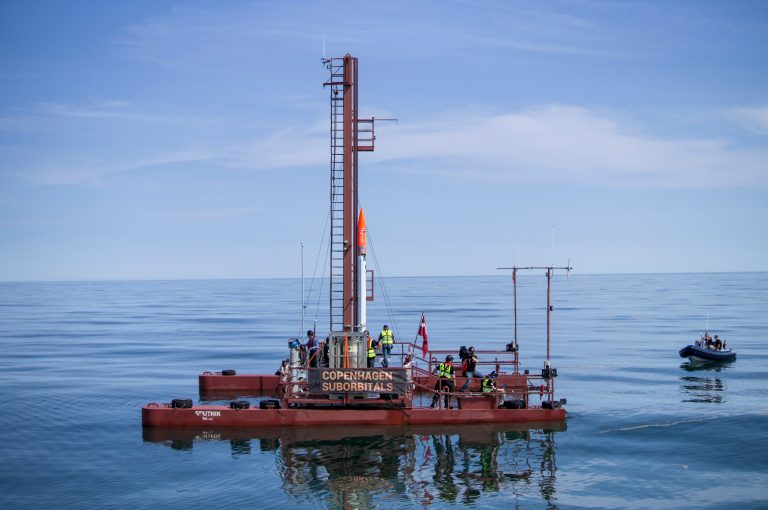
Scott reconfiguring the network aboard Sputnik. Completely calm and perfect launch weather. Photo: Carsten Olsen.
This has taken a lot of extra time, but we are finally starting the actual launch procedure aboard Sputnik shortly after noon. Disregarding an IP conflict between two laptops, everything goes according to plan until start of LOX tanking. Or rather, the first part of the LOX tanking goes smoothly, approximately 30 kg are transferred. At this point we (regrettably) decide to unmount the LOX feed line and close the vent valve to do the best mass measurement possible. This shows that we are around 7 kg short, leading us to reconnect the LOX dewar and open the vent valve on the LOX tank. This is where we encounter a critical error. An error which is the main cause for Nexø I not reaching the expected altitude.
The vent valve only opens the pilot part of the valve. The aperture in this part is too small to vent a sufficient amount of GOX. From here on we have essentially lost control over the pressure in the LOX tank. Having the rocket in direct sunlight with rising pressure in the tank leads to increasing temperature and decreasing density in the LOX. The LOX heats sufficiently that only the high pressure keeps is subcritical. I seriously consider calling a scrub and head home. I confer briefly with Scott, and he reminds me that as Flight the
decision is mine to make. As you all know, the decision was to continue and launch Nexø I.
A decision that was made while also having unwanted vessels in the launch zone. Hjortø was immediately asked to evict the vessels from the zone. Apart from that, our allotted slot with ATC Malmö was less than 30 minutes from expiration. In truth a couple of stressful minutes.
We continue the tanking to reach the correct amount of LOX. As we stopped tanking, the tank pressure was almost 10 bar. That is, GOX at 10 bar. This means that the LOX in the tank now has a lower density and an increasing temperature, while being kept subcritical by the high pressure alone. The result is shown in Mejlings video above.
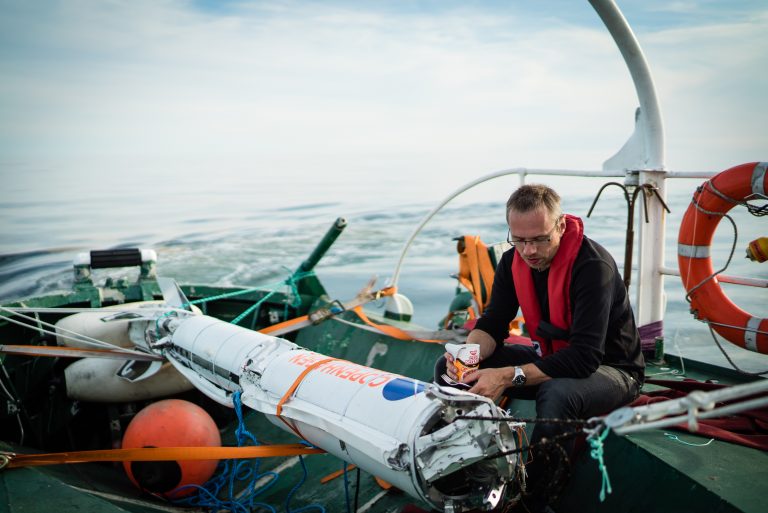
Guidance Officer (GUIDO) Nyboe at a reflective moment by Nexø I, cup noodles in hand.
Photo: Thomas Pedersen.
After launch we have had the opportunity to look a bit at the logged data. There’s been a lot of talk about the amount of LOX being incorrect, an assumption we no longer support, at least not that the amount of LOX was the main problem. The load cell system has been tested vigorously. Also under cryogenic conditions, with liquid nitrogen.
Instead we find that the root cause is the malfunction of the vent valve and the subsequent warming of the LOX. “Warm” LOX that is held subcritical at a high pressure will will become instantly gaseous as soon as the pressure decreases. Thus GOX, and not LOX, will most probably pass through the injector, which is not what it is designed for. The mixing in the engine will not happen as intended, the O/F ratio will be incorrect and thrust will be low. We will however need to look closer at the logged data before comitting fully to this.
This should hopefully be done in a couple of days, which will spawn a true data blog. Until then I have obtained a graph from Flemming showing Nexø I pitch as a function of time. When Flemming says true vertical, he really means true vertical!
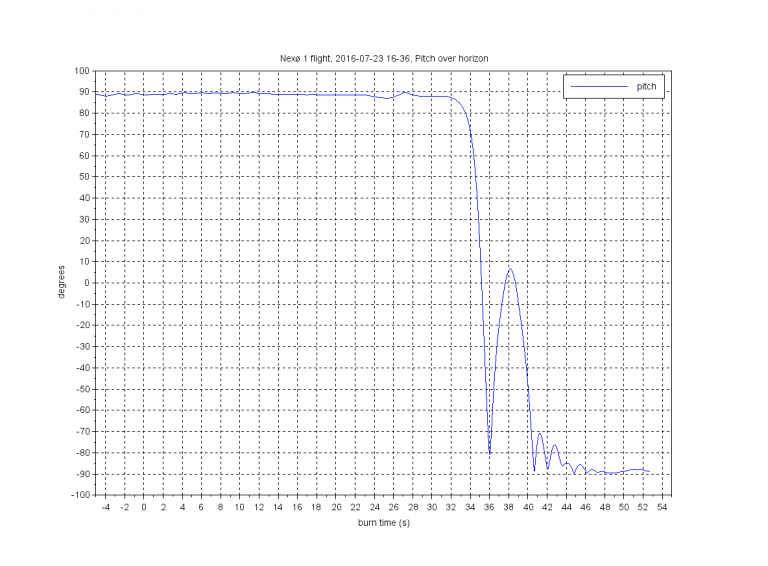
Nexø I pitch. Graphics: Flemming Nyboe.
Despite not having tested the parachute this time either, and despite the underperformance of Nexø I, we are quite
satisfied. Especially GUIDO has made an impression (again). With an acceleration just shy of 10 m/s^2 and a maximum velocity around 300 km/t the guidance still succeed in keeping the rocket absolutely vertical. At a velocity this low the fins hardly add stability, all of the stability is delivered by guidance, which is very impressive.
Regarding the problems with the vent valve during LOX tanking, we will have to go back to the drawing board. We have not encountered this error during more than 30 static tests in our test stand. There is a clear need to “test as you fly, fly as you test”, thus we plan to use the tanks from Nexø I in a modified test setup. This will enable us to test using the exact volumes and thermal masses which will be in use in Nexø II flight. This also means that Nexø II will not fly in 2016.
Sunday night shortly after midnight all equipment, apart from Sputnik and Vostok, was back in our Copenhagen workshop. A full launch campaign has been executed in only 6 days and 5 hours from the word “GO” on Monday evening at 7 PM. Not bad at all, if we may say so ourselves.
Last but not least we owe thanks to all our loyal supporters. Your support through recent years has made it possible for us to manufacture probably the most vigorously tested rocket engine in Denmark, and even launch it on the Nexø I rocket. Without CS Support the project would not have been financially impossible, and we are very grateful for your continued support!





7 Comments
Comments are closed.